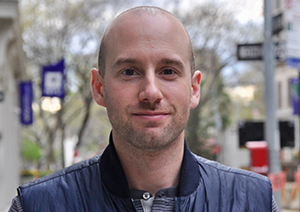Congratulations to the 2017 Brain Star award recipients
| Recipient |
|---|

Andrew Kaplan (Marlene Reimer Brain Star of the Year)PhD student, Institut et hôpital neurologiques de Montréal, Montreal Neurological Institute and Hospital Kaplan A, Morquette, B, Kroner A, Leong S, Madwar C, Sanz R, Banerjee SL, Antel J, Bisson N, David S, Fournier AE (2017). Small-molecule stabilization of 14-3-3 adaptor protein-protein interactions stimulates axon regeneration. Neuron. 2017 Mar 8;93(5):1082-1093.e5. Spinal cord injury is a life-altering condition. Unlike broken bones or cuts on the skin, the injured spinal cord does not heal and restore function. The spinal cord relays signals between the brain and the body along bundles of thin projections called axons, much like electrical cables. Once severed, these axons do not spontaneously re-grow, leaving a gap in brain-body communication that results in paralysis and sensory loss. However, we discovered that a class of natural small molecules derived from a strain of fungus can unlock repair mechanisms to promote axon re-growth. We are now further developing these molecules to maximize their capacity to stimulate axon re-growth and improve their suitability as potential drugs to repair spinal cord damage. |

Nicole BurmaPhD candidate, University of Calgary Blocking microglial pannexin-1 channels alleviates morphine withdrawal in rodents. Burma, N.E. et al. Nature Medicine. 23(3): 355-360. 2017. Opioids are revered as potent analgesics, and while they are often useful for short term therapies, they are increasingly recognized as responsible for a host of adverse effects. For individuals who wish to decrease or stop using opioids, one of the key barriers is withdrawal, which can drive ongoing opioid use. In a recent study, we demonstrated that the pannexin-1 (Panx1) channel is a principal node for opioid withdrawal, and an unanticipated therapeutic target for treating this condition. Since targeting this pathway had no impact on morphine analgesia, blocking Panx1 could provide an adjuvant therapy that leaves the potent pain-relieving effects of opioids intact. As proof-of-concept for the potential clinical translation of Panx1 targeted therapies, we demonstrate the potent amelioration of opioid withdrawal by clinically utilized broad-spectrum Panx1 blockers probenecid (an anti-gout medication) and mefloquine (an anti-malarial compound). Our findings represent a paradigm shift in understanding how opioid withdrawal occurs. |

Lauran ColeMSc Candidate (Neuroscience), Calgary Pediatric Stroke Program, University of Calgary Clinical characteristics, risk factors, and outcomes associated with Neonatal Hemorrhagic Stroke: A population based epidemiological study. Cole L, Dewey D Letourneau N, Kaplan BJ, Chaput K, Gallagher C, Hodge J, Floer A, Kirton A. JAMA Pediatr. 171(3):230–238. 2017 Hemorrhage into the brain of term newborns often results in lifelong disability. The fundamental clinical epidemiology of neonatal hemorrhagic stroke (NHS) remains undefined, hindering the development of strategies to improve outcomes. We aimed to characterize the incidence, associated factors, and outcomes of neonatal hemorrhagic stroke. This population-based case-control study found a neonatal hemorrhagic stroke incidence of 1 in 6,300 live births and independent associations between idiopathic neonatal hemorrhagic stroke and lower maternal age, primiparity, prior spontaneous abortion, difficult fetal transition, and small for gestational age. Outcomes were poor in approximately 50% of infants including sensorimotor delays and epilepsy. NHS is more common than previously reported, occurring in at least 1 in 6,300 live births. Clinical associations do not suggest a common mechanism and recurrence is rare. Outcomes are often poor, mandating attention to prevention and rehabilitation. |

Patrick CiechanskiMD Student, University of Alberta Transcranial Direct-Current Stimulation Can Enhance Motor Learning in Children. Ciechanski P, Kirton A. Cerebral Cortex. 27(5): 2758-2767. 2017 This publication signifies a substantial advancement in the field of pediatric neuromodulation. Our findings serve as a fundamental investigation in the translation of transcranial direct-current stimulation (tDCS) towards clinical utility. Here we demonstrated in what is one of the largest pediatric tDCS trials to date, that the application of tDCS is feasible, safe, and tolerable in healthy children. Our novel findings suggested that targeting certain regions of the motor system with tDCS can enhance motor skill acquisition in children. |

Dun MaoPostdoctoral scholar, Neuroscience, Baylor College of Medicine, USA Mao, D., Kandler, S., McNaughton, B. L., & Bonin, V. (2017). Sparse orthogonal population representation of spatial context in the retrosplenial cortex. Nature Communications, 8(1), 243. Successful spatial navigation and memory formation are believed to be tightly linked to the hippocampus, a deep brain structure that is perhaps one of the most studied brain areas. Hippocampus needs to work together with other brain regions to support those cognitive functions. By monitoring thousands of neurons, we uncovered new, striking neural activity patterns, in the retrosplenial cortex, that resemble the activity in the hippocampus. We showed that the retrosplenial cortex carries rich spatial information, which is likely inherited from the hippocampus. These results pave the way for better understanding how the hippocampal-cortical networks work in concert to process spatial information and use that to support memory, in both health and those with disease. |

Gisella VetereResearch Fellow, The Hospital for Sick Children, Toronto, ON Vetere, G., Kenney, J.W., Tran, L.M., Xia, F., Steadman, P.E., Parkinson, J., Josselyn, S.A., & Franklan, P.W., Chemogenetic Interrogation of a Brain-wide Fear Memory Network in Mice, Neuron 94, 363–374. 2017 Memory serves as the foundation of knowledge, awareness and thinking. Making an understanding of memory is fundamental to grasping the working of the brain in both health and disease. This paper presents and validates an innovative way to analyze how a broad network of brain regions communicates and interacts after the acquisition of an aversive event to store and recall a memory trace. Using a combination of computational and experimental approaches, Vetere et al. provide evidence that hub regions (regions with more functional connections) within the memory network play disproportionately influential roles in memory consolidation. The current study indicates that the network approach provides a predictive framework that may be useful in identifying novel brain-behavior relationships. Most importantly, this approach can be used in the future to predict brain regions that are impaired in cognitive diseases. |

Fergil Mills and Andrea GlobaFergil Mills, Postdoctoral fellow, Massachusetts Institute of Technology Andrea Globa, Business Development Specialist, Mitacs Mills F, Globa AK, Liu S, Cowan CM, Mobasser M, Phillips AG, Borgland SL, Bamji SX. Cadherins mediate cocaine-induced synaptic plasticity and behavioral conditioning. Nature Neuroscience In this study, Dr. Mills and Dr. Globa demonstrate that cadherin adhesion molecules play a critical role in mediating cocaine-induced changes in synaptic plasticity and behaviour. Addiction is believed to be the result of strengthening of synaptic connections in the reward pathway of the brain, which leads to long-lasting behavioral changes. Drs. Mills and Globa found that cadherin molecules mediate these changes in synaptic strength, and most strikingly, were able to inhibit cocaine-induced behavioural changes in transgenic mice by manipulating cadherin adhesion. Their work shows that that drug-induced learning can be manipulated without compromising learning and memory in other parts of the brain, and provides mechanistic insight into how mutations in cadherin adhesion complex proteins may contribute to susceptibility or resilience to addiction in humans. |

Robin KimPharmacology, Faculty of Medicine, University of Alberta Kim, R.Y., Pless, S.A., and Kurata, H.T. (2017). PIP2 mediates functional coupling and pharmacology of neuronal KCNQ channels. Proc. Natl. Acad. Sci. USA 114, E9702–E9711. Despite the availability of many drugs to treat epilepsy, nearly one-third of patients are not responsive to pharmacotherapy. Retigabine is the first approved antiepileptic drug that acts by promoting activation of potassium channels, specifically targeting neuronal KCNQ channels that play an essential role in the regulation of neuronal excitability. In this study we demonstrate that a lipid molecule called PIP2, which is present in all brain cells, is essential for the effects of retigabine. In the absence of PIP2, retigabine is no longer able to open the pore of KCNQ potassium channels. This is due to the role of PIP2 in acting as a 'hinge', translating the effects of retigabine binding in the voltage-sensing region of the channel to structural changes that ultimately result in pore opening. This finding provides important insights into the function of KCNQ channels as well as the mechanisms of an emerging drug class with potential utility in various neurological disorders. |

Dave LiuPostdoctoral fellow, Janelia Research Campus, Howard Hughes Medical Institute Liu LD & Pack CC. The Contribution of Area MT to Visual Motion Perception Depends on Training. Neuron. 95: 436-446. 2017 In our paper, Dr. Christopher Pack and I found that the specific cortical area used for motion perception depends on the type of stimulus that an animal is trained to discriminate. After extensive training on one stimulus, the brain region most sensitive to this stimulus will be functionally preferred. Importantly, this area will assume the contribution of other regions previously used for motion perception. This study opens a new approach for training the brain, especially when a lesion destroys a particular area. Training based on the characteristic sensitivity of the non-damaged regions can improve their potential to replace the function of the damaged region. Training the brain to use different regions for the same task can one day result in non-invasive therapies for brain damage caused by stroke and traumatic brain injury. |

Ina AnreiterMSc. University of Toronto, Department of Ecology and Evolutionary Biology, Toronto, ON. Anreiter I, Kramer JM, Sokolowski MB. Epigenetic mechanisms modulate differences in Drosophila foraging behavior. PNAS 114(47): 12518–12523. Individuals of the same species often display remarkable variation in behaviour even in identical contexts, but the molecular mechanisms that underlie this variation are still poorly understood. Our study investigates how the interaction of two genes, foraging (a signaling molecule) and G9a (an epigenetic regulator) mediates individual differences in feeding behaviour and metabolism. Both foraging and G9a have conserved function in humans with wide implications in human health and disease. Specifically, both genes are associated with behaviour, metabolism, and cognitive functions in humans and flies. This study presents important new findings on the regulation of behavioural variation, not only because it is the first to show a link between G9a and foraging, but also because it provides some of the first causal evidence for how epigenetic regulators depend on underlying genetic differences to mediate behaviour. |

Corey BaimelPostdoctoral fellow, Center for Neural Science, New York University Baimel C, Lau BK, Qiao M, Borgland SL. Projection-Target-Defined Effects of Orexin and Dynorphin on VTA Dopamine Neurons. Cell Reports. 18: 1346-1355. Motivation is controlled by many different areas of the brain. Two important regulators of motivated behaviour are the chemical messengers orexin and dynorphin. One specialized type of nerve cell, orexin neurons, can release both orexin and dynorphin, which then interact with other brain cells throughout the brain to increase or decrease their activity. One particularly important interaction is between these messengers and the midbrain dopamine neurons, which help promote goal-directed actions. But we aren’t sure how orexin and dynorphin change the activity of dopamine neurons. In our paper, we try to understand which characteristics of dopamine neurons influence their reaction to orexin and dynorphin. We found that the reaction to orexin and dynorphin changes depending on the brain regions with which dopamine neurons communicate. Our findings suggest that orexin and dynorphin may work together to coordinate how dopamine neurons are turned on or off to impact goal-directed actions. |

Katelynn BoernerPostdoctoral Psychology Fellow, BC Children's Hospital Boerner, K.E., Chambers, C.T., McGrath, P.J., LoLordo, V., & Uher, R. (2017). The effect of parental modeling on child pain responses: The role of parent and child sex. The Journal of Pain, 18(6), 702-715 Pain tends to run in families, and children who have a parent with chronic pain are more likely to experiencing chronic pain themselves. Research has shown us that this relationship is not just because of genetic factors. One factor that may be at play is how much parents act as models for their children’s behaviour. This study looked at the effect of observing a parent in pain on children’s own pain experiences. Our results showed that children who observed their parents exaggerating an expression of pain reported feeling more anxious than children of parents who minimized their expression of pain. We also found that when children observed their parents exaggerating an expression of pain, girls reported experiencing more pain themselves than boys. This study helps us understand the relationship between parental modeling of pain behaviours and children’s pain, which may help us develop treatments for families with pain. |

Corinne ZinflouPh.D. student, CHU de Québec Research Center – Université Laval Zinflou C, Rochette PJ. "Ultraviolet A-induced oxidation in cornea: Characterization of the early oxidation-related events". Free Radical Biology and Medicine. 2017 Jul; vol 108: pp 118-128. PMID: 28342848 Ultraviolet A (UVA) rays have a high toxicity potential and account for 95% of the solar UV radiation that our eyes are exposed to on a daily basis. The cornea, the transparent, anterior surface of the eye, is most affected. It filters out much of the UVA rays, thus providing essential protection for the internal structures of the eye. However, the toxic effect of UVA rays poses a significant risk to the cornea, and data suggest that these rays promote premature aging and various corneal diseases. By examining the first signs of toxicity caused by UVA rays to the cornea, and by determining how the cornea reacts to this toxicity, this project is the first to identify areas of the cornea that are most vulnerable to UVA rays and indicates how UVA radiation can affect the cornea. |

Mark WadeBanting Postdoctoral Fellow, Harvard Medical School and Boston Children’s Hospital Wade, M., Prime, H., Hoffmann, T.J., Schmidt, L.A., O’Connor, T.G., & Jenkins, J.M. (2017). Birth weight interacts with a functional variant of the oxytocin receptor (OXTR) gene to predict executive functioning in children. Development and Psychopathology. Executive functioning is a set of skills that enables children to flexibly think about problems, juggle multiple things at once, and plan, organize, and inhibit behavior. When these abilities do not develop properly, children are at risk for a host of later problems, including disruptive behavior and ADHD. Executive functioning is influenced by both biology and the environment, yet there is little known about how these factors combine to shape its development. In a large and diverse sample of children, I showed that a genetic marker in the oxytocin system (which is heavily implicated in social functioning) interacts with children’s birth weight (a proxy for fetal growth) in predicting preschoolers’ executive functioning. The results suggest that genetic influences on executive functioning may be modulated by prenatal factors, and highlight the importance of identifying children who may be at risk of later difficulties early in development to ensure they proceed along an adaptive developmental trajectory. |

Drew DeBayPhD candidate, Medical Neuroscience, Faculty of Medicine, Dalhousie University DeBay DR, Reid GA, Pottie IR, Martin E, Bowen CV, Darvesh S. Targeting butyrylcholinesterase for preclinical single photon emission computed tomography (SPECT) imaging of Alzheimer's disease. Alzheimers Dement (N Y). 2017 Feb 24;3(2):166-176. There are currently no effective means to definitively diagnose Alzheimer’s disease (AD) during life. Brain imaging of plaques and tangles in the AD brain is limited, as similar changes are found in ~30% of cognitively normal individuals. We have recently shown that the protein butyrylcholinesterase (BChE), typically present in high levels in the AD brain, is a highly sensitive and specific biomarker for the disease and could therefore provide greater accuracy as an AD diagnostic. In this paper, we have developed a radiotracer for brain imaging that targets BChE. These brain scans have effectively distinguished an AD brain from that of a healthy control in an animal model. Brain imaging of BChE in humans may enhance the accuracy and timely detection of AD not yet possible with current brain imaging methods. If successful, this research has potential to impact how we diagnose, manage and perhaps how we eventually even treat AD. |

Mirela AmbeskovicPhD. Candidate, Canadian Centre for Behavioural Neuroscience, University of Lethbridge Ambeskovic M, Soltanpour N, Falkenberg EA, Zucchi FCR, Kolb B, Metz GAS. Ancestral Exposure to Stress Generates New Behavioral Traits and a Functional Hemispheric Dominance Shift. Cereb Cortex, 1;27(3):2126-2138, 2017. This paper is very timely in the current advancement of neuroscience through epigenetics. It builds on the previous research showing that the early life experiences influence brain and behavioural health outcomes later in life. Here we show that adverse early environment such as prenatal stress not only affect the individual directly exposed but also impact the brain organisation and behavioural traits of later descendants. Specifically, cumulative multigenerational stress across four consecutive generations resulted in sexually dimorphic left-handedness, dominance shift toward the right hemisphere, and impaired fine motor skills in males. On the contrary, generational stress promoted resilience and improved motor functionality in females. Thus, present findings may explain the origins of apparently heritable behavioural traits and handedness in the absence of DNA sequence variations while proposing epigenetic mechanisms. These findings may have implications for other behavioural abnormalities and mental disorders, especially of vulnerable populations such homeless and migrants. |

Vivek MahadevanVisiting Scientist, Section on Cellular and Synaptic Physiology, Bethesda MD Mahadevan, V., Khademullah, C.S., Dargaei, Z., Chevrier, J., Uvarov, P., Kwan, J., Bagshaw, R.D., Pawson, T. & Emili, A. Native KCC2 interactome reveals PACSIN1 as a critical regulator of synaptic inhibition. Elife 2017 10 13;6 In the brain, GABA is a chief neurotransmitter that decreases (inhibits) the activity of neurons. Its efficient function is determined by the transporter protein KCC2 that maintains a low amount of chloride ions inside neurons. If KCC2 fails to work, the chloride builds up leads to a breakdown of GABA inhibition, which is a hallmark of neurological disorders like epilepsy, pain and autism. Despite the fact that neurons need KCC2 for inhibition, we know little about how KCC2 works. Since the activity of a protein is determined in part by the other proteins it interacts with, Mahadevan et al. identified the proteins that interact with KCC2 – termed the KCC2 interactome. The KCC2 interactome provides a database of proteins that can be targeted to increase the activity of KCC2 and strengthen GABA inhibition. This could allow new treatments to be developed for brain disorders where the inhibition of neurons is reduced. |
- Date modified: